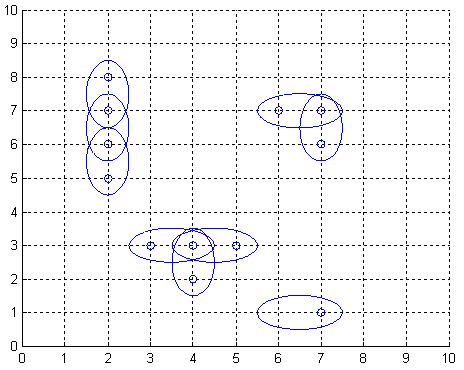http://poj.org/problem?id=3020
Antenna Placement
| Time Limit: 1000MS | Memory Limit: 65536K | |
| Total Submissions: 7565 | Accepted: 3758 |
Description
The Global Aerial Research Centre has been allotted the task of building the fifth generation of mobile phone nets in Sweden. The most striking reason why they got the job, is their discovery of a new, highly noise resistant, antenna. It is called 4DAir, and comes in four types. Each type can only transmit and receive signals in a direction aligned with a (slightly skewed) latitudinal and longitudinal grid, because of the interacting electromagnetic field of the earth. The four types correspond to antennas operating in the directions north, west, south, and east, respectively. Below is an example picture of places of interest, depicted by twelve small rings, and nine 4DAir antennas depicted by ellipses covering them.

Obviously, it is desirable to use as few antennas as possible, but still provide coverage for each place of interest. We model the problem as follows: Let A be a rectangular matrix describing the surface of Sweden, where an entry of A either is a point of interest, which must be covered by at least one antenna, or empty space. Antennas can only be positioned at an entry in A. When an antenna is placed at row r and column c, this entry is considered covered, but also one of the neighbouring entries (c+1,r),(c,r+1),(c-1,r), or (c,r-1), is covered depending on the type chosen for this particular antenna. What is the least number of antennas for which there exists a placement in A such that all points of interest are covered?

Obviously, it is desirable to use as few antennas as possible, but still provide coverage for each place of interest. We model the problem as follows: Let A be a rectangular matrix describing the surface of Sweden, where an entry of A either is a point of interest, which must be covered by at least one antenna, or empty space. Antennas can only be positioned at an entry in A. When an antenna is placed at row r and column c, this entry is considered covered, but also one of the neighbouring entries (c+1,r),(c,r+1),(c-1,r), or (c,r-1), is covered depending on the type chosen for this particular antenna. What is the least number of antennas for which there exists a placement in A such that all points of interest are covered?
Input
On the first row of input is a single positive integer n, specifying the number of scenarios that follow. Each scenario begins with a row containing two positive integers h and w, with 1 <= h <= 40 and 0 < w <= 10. Thereafter is a matrix presented, describing the points of interest in Sweden in the form of h lines, each containing w characters from the set ['*','o']. A '*'-character symbolises a point of interest, whereas a 'o'-character represents open space.
Output
For each scenario, output the minimum number of antennas necessary to cover all '*'-entries in the scenario's matrix, on a row of its own.
Sample Input
2 7 9 ooo**oooo **oo*ooo* o*oo**o** ooooooooo *******oo o*o*oo*oo *******oo 10 1 * * * o * * * * * *
Sample Output
17 5
详细请参考:
http://blog.csdn.net/ripwangh/article/details/47334941
题目大意:
给定一个地图,*代表城市,o代表空地,用天线来覆盖相邻的两个城市,问最少需要多少天线?(所谓相邻是指上下左右4个方向相邻)
最小路径覆盖问题,难点就是如何构图
假如是这个例子:
2
3 3
*oo
***
o*o
统计城市数量,并将其编号:
2
3 3
1oo
234
o5o
第一个城市编号1,天线可覆盖与它相邻的城市2,则1与2之间有一条连线也就是1与2匹配即G[1][2]= 1;
第二个城市编号2,天线可覆盖与它相邻的城市1,3;则G[2][1]=1,G[2][3]=1;
同理可得G[3][2]=1,G[3][4]=1,G[3][5]=1,G[4][3]=1,G[5][3]=1
将城市拆分成两部分分别存入集合X和集合Y中
X Y
1 1
2 2
3 3
4 4
5 5
构图后为:
| X | 1 | 2 | 3 | 4 | 5 | |
| Y | ||||||
| 1 | 0 | 1 | 0 | 0 | 0 | |
| 2 | 1 | 0 | 1 | 0 | 0 | |
| 3 | 0 | 1 | 0 | 1 | 1 | |
| 4 | 0 | 0 | 1 | 0 | 0 | |
| 5 | 0 | 0 | 1 | 0 | 0 |
最小路径覆盖 = 总点数 - 最大匹配数
由于将城市拆分成两份,所以求得的最大匹配应该除以2

#include<stdio.h> #include<queue> #include<string.h> #include<algorithm> #define INF 0x3f3f3f3f #define N 1010 using namespace std; int G[N][N], A[N][N], vis[N], used[N]; char maps[N][N]; int m, n, k, d[4][2] = {{0, 1}, {0, -1}, {1, 0}, {-1, 0}}; bool Find(int u)//求最大匹配 { int i; for(i = 1 ; i <= k ; i++) { if(!vis[i] && G[u][i]) { vis[i] = 1; if(!used[i] || Find(used[i])) { used[i] = u; return true; } } } return false; } void Build(int x, int y)//构图 { int a, b, i; for(i = 0 ; i < 4 ; i++)//无线会覆盖东南西北四个方向 { a = x + d[i][0]; b = y + d[i][1]; if(a >= 1 && a <= m && b >= 1 && b <= n) { G[A[x][y]][A[a][b]] = 1; G[A[a][b]][A[x][y]] = 1; } } } int main() { int t, i, j; scanf("%d", &t); while(t--) { scanf("%d%d", &m, &n); memset(G, 0, sizeof(G)); memset(A, 0, sizeof(A)); k = 1; for(i = 1 ; i <= m ; i++) { getchar(); for(j = 1 ; j <= n ; j++) { scanf("%c", &maps[i][j]); if(maps[i][j] == '*') { A[i][j] = k;//A[i][j]表示坐标为(i,j)这个城市的编号 k++; } } }//统计城市个数,并对其进行编号 k -= 1; for(i = 1 ; i <= m ; i++) { for(j = 1 ; j <= n ; j++) { if(A[i][j])//每找到一个城市便根据其对其四周进行构图 Build(i, j); } } int ans = 0; memset(used, 0, sizeof(used)); for(i = 1 ; i <= k ; i++) { memset(vis, 0, sizeof(vis)); if(Find(i)) ans++; } printf("%d ", k - ans / 2); } return 0; } /* 2 3 3 *oo *** o*o */
